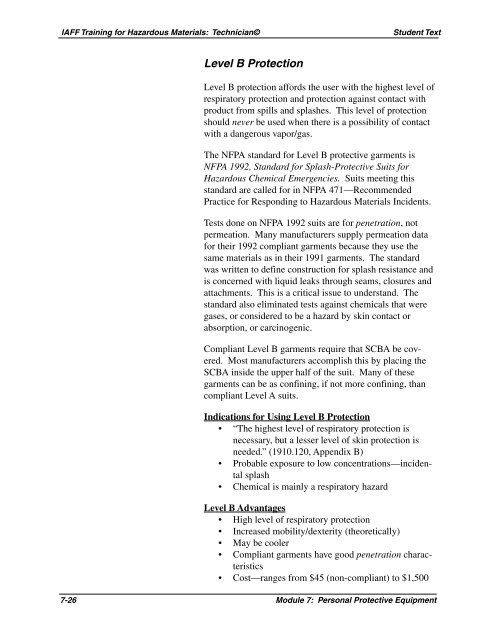Module 7 - IAFF
Module 7 - IAFF
Module 7 - IAFF
You also want an ePaper? Increase the reach of your titles
YUMPU automatically turns print PDFs into web optimized ePapers that Google loves.
<strong>IAFF</strong> Training for Hazardous Materials: Technician©<br />
Student Text<br />
Level B Protection<br />
Level B protection affords the user with the highest level of<br />
respiratory protection and protection against contact with<br />
product from spills and splashes. This level of protection<br />
should never be used when there is a possibility of contact<br />
with a dangerous vapor/gas.<br />
The NFPA standard for Level B protective garments is<br />
NFPA 1992, Standard for Splash-Protective Suits for<br />
Hazardous Chemical Emergencies. Suits meeting this<br />
standard are called for in NFPA 471—Recommended<br />
Practice for Responding to Hazardous Materials Incidents.<br />
Tests done on NFPA 1992 suits are for penetration, not<br />
permeation. Many manufacturers supply permeation data<br />
for their 1992 compliant garments because they use the<br />
same materials as in their 1991 garments. The standard<br />
was written to define construction for splash resistance and<br />
is concerned with liquid leaks through seams, closures and<br />
attachments. This is a critical issue to understand. The<br />
standard also eliminated tests against chemicals that were<br />
gases, or considered to be a hazard by skin contact or<br />
absorption, or carcinogenic.<br />
Compliant Level B garments require that SCBA be covered.<br />
Most manufacturers accomplish this by placing the<br />
SCBA inside the upper half of the suit. Many of these<br />
garments can be as confining, if not more confining, than<br />
compliant Level A suits.<br />
Indications for Using Level B Protection<br />
• “The highest level of respiratory protection is<br />
necessary, but a lesser level of skin protection is<br />
needed.” (1910.120, Appendix B)<br />
• Probable exposure to low concentrations—incidental<br />
splash<br />
• Chemical is mainly a respiratory hazard<br />
Level B Advantages<br />
• High level of respiratory protection<br />
• Increased mobility/dexterity (theoretically)<br />
• May be cooler<br />
• Compliant garments have good penetration characteristics<br />
• Cost—ranges from $45 (non-compliant) to $1,500<br />
7-26 <strong>Module</strong> 7: Personal Protective Equipment
















